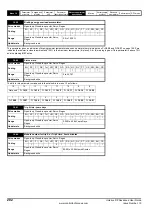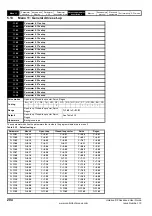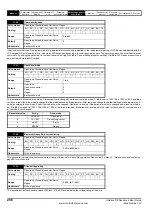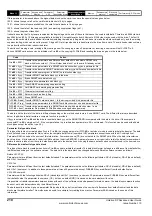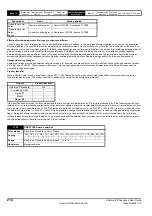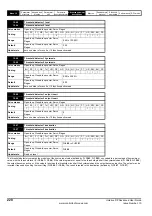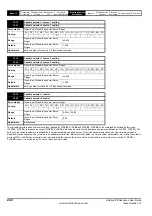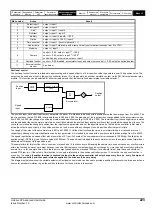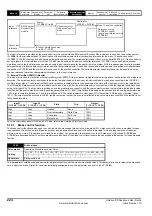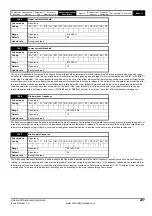
Menu 11
Parameter
structure
Keypad and
display
Parameter
x.00
Parameter
description format
Advanced parameter
descriptions
Macros
Serial comms
protocol
Electronic
nameplate
Performance RFC mode
214
Unidrive SP Advanced User Guide
www.controltechniques.com Issue Number: 10
* Modes 1 and 2 are not US (i.e. not saved when drive parameters are saved), mode 3 and 4 are US.
Therefore this parameter can only be saved to EEPROM if it has a value of 0, 3 or 4.
Reading (1)
Setting Pr
11.42
to 1 and resetting the drive will transfer the data from the card into the drive parameters and then the drive EEPROM, provided data
block 1 exists and is a parameter file for the current drive mode. All smart card trips apply. When the action is complete this parameter is automatically
reset to zero.
Programming (2)
Setting Pr
11.42
to 2 and resetting the drive will save the parameters to a card, i.e. equivalent to writing 3001 to Pr
x.00
. If the data block already
exists it is automatically over-written. When the action is complete this parameter is automatically reset to zero.
Auto (3)
Changing Pr
11.42
to 3 and resetting the drive will save the complete parameter set from the drive parameters to the card, i.e. equivalent to writing
3001 to Pr
x.00
. If the data block already exists it is automatically overwritten. If the card is removed when Pr
11.42
is set to 3, Pr
11.42
will be set to
0. The action of setting Pr
11.42
to 0 when a card is removed forces the user to change Pr
11.42
back to 3 if auto mode is still required. The user will
need to set Pr
11.42
to 3 and reset the drive to write the complete parameter set to the new card.
When a parameter in menu zero is changed via the keypad and a card is installed the parameter is saved both to the drive EEPROM and the card.
Only the new value of the modified parameter is written to the EEPROM and the card. If Pr
11.42
was not cleared automatically when a card is
removed, then when a new card is inserted that contains data block 1 the modified parameter would be written to the existing data block 1 on the new
card and the rest of the parameters in this data block may not be the same as those in the drive.
When Pr
11.42
is equal to 3 and the parameters in the drive are saved, the card is also updated, therefore the card becomes a copy of the drive
parameters. At power up, if Pr
11.42
is set to 3, the drive will save the complete parameter set to the card. This is done to ensure that if a card is
inserted while the drive is powered down the new card will have the correct data after the drive is powered up again.
Boot (4)
When Pr
11.42
is set to 4 the drive operates in the same way as with Pr
11.42
set to 3 and automatically creates a copy of it parameters on a SMART
card. Pr
11.42
has the NC (not clonable) attribute, and so it does not have a value stored on a SMART card in the normal way. However, when data is
transferred to a card from the source drive the value of this parameter is held in the header of parameter or difference from default file type data
blocks so that the destination drive can detect when boot transfer is required on power-up (i.e. the source drive had this parameter set to 4). If a card
is present at power up, and it has Pr
11.42
stored as 4 in the header of a parameter file or difference from default file as data block 1 then the following
actions are taken.
1. The parameters from data block 1 are transferred to the drive and then saved in drive EEPROM.
2. If data block 2 exists and is type 17 the user program from this data block is transferred to the drive.
3. Parameter Pr
11.42
is set to zero after the data transfer is complete.
It is possible to create a difference from default bootable file by setting parameter Pr
x.00
to 2001 and resetting the drive. This type of file causes the
drive to behave in the same way at power-up as a file created with boot mode set up with Pr
11.42
. The difference from default file has the added
advantage of including menu 20 parameters. A bootable difference from default file can only be created in one operation and parameters cannot be
added as they are saved via menu zero.
When the drive is powered up it detects which Solutions Modules are installed before loading parameters from a SMART card which has been set up
for boot mode. If a new Solutions Module has been installed since the last time the drive was powered up, the drive produces a SLx.dF trip and then
proceeds to transfer the parameters from the SMART card. If the parameter data in the card includes the parameters for the newly installed Solutions
Module then these are also transferred to the drive. Once the transfer is complete the drive parameters are automatically saved to the drive
EEPROM. The SLx.dF trip can be reset either by resting the drive or powering down and then powering up again. Because the parameters are
transferred to the drive after detecting the Solutions Modules it is possible to fit the required Solutions Modules to a drive (corresponding to the
modules installed when the SMART card data was stored) and transfer the parameters to the drive including those for the Solutions Modules.
11.42
Parameter copying
Drive modes
Open-loop, Closed-loop vector, Servo, Regen
Coding
Bit
SP
FI
DE Txt VM DP
ND
RA NC NV PT US RW BU PS
1
1
*
1
1
Range
Open-loop, Closed-loop vector, Servo,
Regen
0 to 4
Default
Open-loop, Closed-loop vector, Servo,
Regen
0
Update rate
Background read
Summary of Contents for unidrive sp
Page 419: ......
Page 420: ...0471 0002 10 ...



